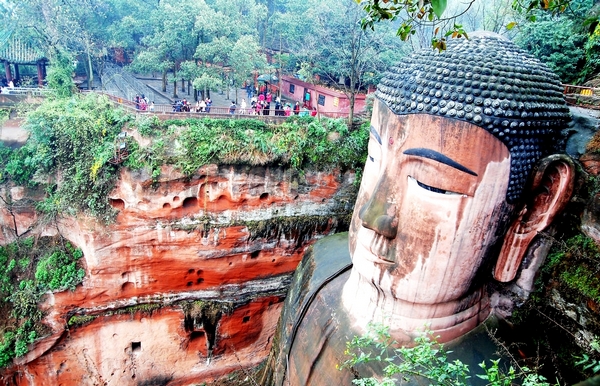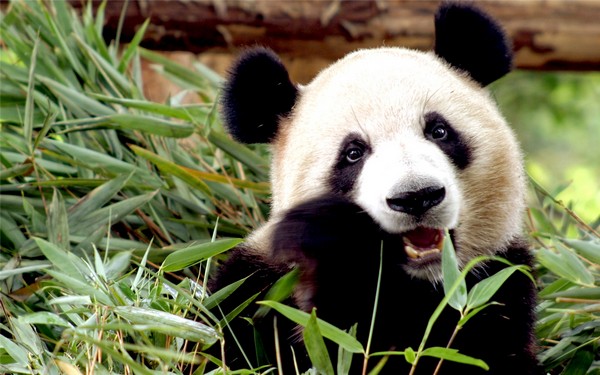
Leshan is the biggest Buddha of the world.
SICHUAN PROVINCE
SICHUAN Province, also called “Chuan” or “Shu”, serves as an important transport corridor connecting the southwest and northwest regions of China, as well as linking China with Central Asia, South Asia, and Southeast Asia.
It has a population of 91 million and an area of 486,000 square kilometers. Its terrain slopes from west to east on the whole and the main landforms include plains, hills, mountains and plateaus.
The climate is mild with plenty of rainfall.

Chengdu’s lovable panda
Awe inspiring natural landscapes, mysterious ancient Shu Civilization, various ethnic cultures, booming modern economy, harmonious and happy social environment and intelligent and industrious Sichuan people have injected dynamics and unique charm into their land.
Central Sìchuan is home to the giant panda, the most famous face in China.
Located just 10 km (6 miles) away from downtown, the Chengdu Research Base of Giant Panda Breeding was created to imitate the natural habitat of giant pandas so they might have the best possible environment for rearing and breeding.
Chengdu, the provincial capital, is also a center for traditional Sichuanese opera, which include fire-breathing and sleight-of-hand mask changes. It is the hub of science and technology, commerce and trade, financial center, traffic and communication.
Cebu City and Chengdu have formed a special bond after the June, 2017 signing of a sister-city partnership. Chengdu Mayor Luo Qiang and his delegation came to Cebu to sign the memorandum of understanding with Cebu City Mayor Tomas Osmeña.
Cebu City officials and guests savored on Sichuan dishes especially prepared by two Sichuanese chefs brought in by Mayor Luo.
Honored as “the most livable city in the world,” “the best tourist city in China” and “the capital of gastronomy in the world” Chengdu was declared by UNESCO in 2011 to be a city of gastronomy to recognize the sophistication of its cooking.
The famous Sichuan cuisine is a style of Chinese cuisine originating from Sichuan Province in southwestern China.
It has bold flavors, particularly the pungency and spiciness resulting from liberal use of garlic and chili peppers, as well as the unique flavor of Sichuan pepper.
Chengdu, the provincial capital, is a center for traditional Sichuanese opera
Most Sichuan dishes are spicy, although a typical meal includes non-spicy dishes to cool the palate.
Milder versions of Sichuan dishes remain a staple of American Chinese cuisine.
Sichuan is also the home to Deng Xiaoping, the general designer of China’s reform and opening-up and socialist modernization.
In Sichuan, nature, people and social custom are staying in harmony with each other, all embodying its name, “the Land of Abundance”. Sichuan boasts of time-honored history and profound culture.
The 5,000-year history has witnessed the grand and beautiful waters and mountains, boundless and fertile Sichuan basin, varied and colorful folk
customs, diverse and inclusive humanist spirits, all giving birth to the culture of Sichuan with abundant deposits and thus forming a unique part in Chinese culture.
The splendid landscapes and amazing nature have endowed this land a great charm.
The province enjoys the largest number of world cultural and natural heritage and national key scenic spots in China, over 4,000 tourist attractions, ranking the top.
Sichuan’s economy is developing fast, and its economic aggregate always takes the first position in Western China. In 2017, the province GDP exceeded RMB 3.6 trillion, ranking the sixth in China.
It is also among the three provinces embracing the pilot reform zone for all-around innovation and the pilot free trade zone at the same time.
Additionally, it will become the third city owning three airports in China.
A new chapter of leaping development is gradually unfolding in Sichuan Province, the land of abundance and the home to panda.
Let’s enjoy it in these beautiful visual images.

